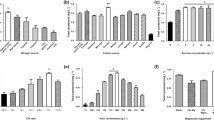Abstract
The photosynthetic bacterium, Rhodobacter sphaeroides, is a bacterium that can grow in a variety of environments and produces substances with antioxidant effects. In this study, we investigated the culture conditions to increase the production of antioxidants in R. sphaeroides, which can grow under both aerobic and anaerobic conditions. After incubation in the exponential phase and stationary phase under both conditions, a 2,2-diphenyl-1-picrylhydrazyl assay was used to confirm the antioxidant effect. Although the highest antioxidant effect was shown in the stationary phase under aerobic conditions, the antioxidant effect of each cell was found to be greater when cultured under anaerobic conditions. The antioxidant activity of R. sphaeroides was increased by sonication. In addition, the contents of carotenoids and bacteriochlorophyll, which are pigments with antioxidant effects, produced by R. sphaeroides were measured. We confirmed that the content of carotenoids was higher in anaerobic conditions than in aerobic conditions. However, when measuring the content of the bacterium, we found that there was more content in aerobic conditions. Therefore, we confirm that when grown in anaerobic conditions, the antioxidant effect of R. sphaeroides is higher, which suggests that this antioxidant effect comes from the effect of carotenoid.




Similar content being viewed by others
References
Roh, J. H., Smith, W. E., & Kaplan, S. (2004). Effects of oxygen and light intensity on transcriptome expression in Rhodobacter sphaeroides 2.4. 1: Redox active gene expression profile. Journal of Biological Chemistry, 279(10), 9146–9155.
Sasaki, K., Watanabe, M., Suda, Y., Ishizuka, A., & Noparatnaraporn, N. (2005). Applications of photosynthetic bacteria for medical fields. Journal of Bioscience and Bioengineering, 100(5), 481–488.
Su, A., Chi, S., Li, Y., Tan, S., Qiang, S., Chen, Z., & Meng, Y. (2018). Metabolic redesign of Rhodobacter sphaeroides for lycopene production. Journal of Agriculture and Food Chemistry, 66(23), 5879–5885.
Kuda, T., Kawahara, M., Nemoto, M., Takahashi, H., & Kimura, B. (2014). In vitro antioxidant and anti-inflammation properties of lactic acid bacteria isolated from fish intestines and fermented fish from the Sanriku Satoumi region in Japan. Food Research International, 64, 248–255.
Yeliseev, A. A., Eraso, J. M., & Kaplan, S. (1996). Differential carotenoid composition of the B875 and B800-850 photosynthetic antenna complexes in Rhodobacter sphaeroides 2.4. 1: Involvement of spheroidene and spheroidenone in adaptation to changes in light intensity and oxygen availability. Journal of Bacteriology., 178(20), 5877–5883.
Stahl, W., & Sies, H. (1996). Lycopene: A biologically important carotenoid for humans? Archives of Biochemistry and Biophysics, 336(1), 1–9.
Fraser, N. J., Hashimoto, H., & Cogdell, R. J. (2001). Carotenoids and bacterial photosynthesis: The story so far…. Photosynthesis Research, 70(3), 249–256.
Tian, B., Xu, Z., Sun, Z., Lin, J., & Hua, Y. (2007). Evaluation of the antioxidant effects of carotenoids from Deinococcus radiodurans through targeted mutagenesis, chemiluminescence, and DNA damage analyses. Biochimica et Biophysica Acta (BBA)-General Subjects, 1770(6), 902–911.
Yu, J., Moon, S. K., Kim, Y. H., & Min, J. (2022). Isoprene production by Rhodobacter sphaeroides and its antimicrobial activity. Research in Microbiology, 173, 103938.
Lee, H. J., Park, J.-Y., Yoo, K. S., Yoon, J., Kim, Y.-H., & Min, J. (2013). Activity and characterization of mixed organic compounds extracted from Rhodobacter sphaeroides as alternative materials to serum for mammalian cell growth. Applied Microbiology and Biotechnology, 97(21), 9561–9567.
Cohen-Bazire, G., Sistrom, W., & Stanier, R. (1957). Kinetic studies of pigment synthesis by non-sulfur purple bacteria. Journal of Cellular and Comparative Physiology, 49(1), 25–68.
Gu, Z., Deming, C., Yongbin, H., Zhigang, C., & Feirong, G. (2008). Optimization of carotenoids extraction from Rhodobacter sphaeroides. LWT - Food Science and Technology, 41(6), 1082–1088.
Acknowledgements
This work was supported by the Korea Institute of Planning and Evaluation for Technology in Food, Agriculture, and Forestry (IPET) through the Crop Viruses and Pests Response Industry Technology Development Program, funded by the Ministry of Agriculture, Food and Rural Affairs (MAFRA) (321108-04).
Author information
Authors and Affiliations
Contributions
SL performed all of the experiments. SL and JY wrote the main manuscript text. Y-HK and JM designed the overall experimental concept and revised the manuscript; approved the final version: all authors.
Corresponding authors
Ethics declarations
Conflict of interest
Subin Lee, Jaeyoung Yu, Yang-Hoon Kim, and Jiho Min declare that they have no conflict of interest.
Informed Consent
Informed consent was obtained from all individual participants included in the study
Research Involving Human Participants and/or Animals
This article does not contain any studies with human participants or animals performed by any of the authors.
Additional information
Publisher's Note
Springer Nature remains neutral with regard to jurisdictional claims in published maps and institutional affiliations.
Rights and permissions
Springer Nature or its licensor holds exclusive rights to this article under a publishing agreement with the author(s) or other rightsholder(s); author self-archiving of the accepted manuscript version of this article is solely governed by the terms of such publishing agreement and applicable law.
About this article
Cite this article
Lee, S., Yu, J., Kim, YH. et al. Optimized Rhodobacter sphaeroides for the Production of Antioxidants and the Pigments with Antioxidant Activity. Mol Biotechnol 65, 131–135 (2023). https://doi.org/10.1007/s12033-022-00547-4
Received:
Accepted:
Published:
Issue Date:
DOI: https://doi.org/10.1007/s12033-022-00547-4




